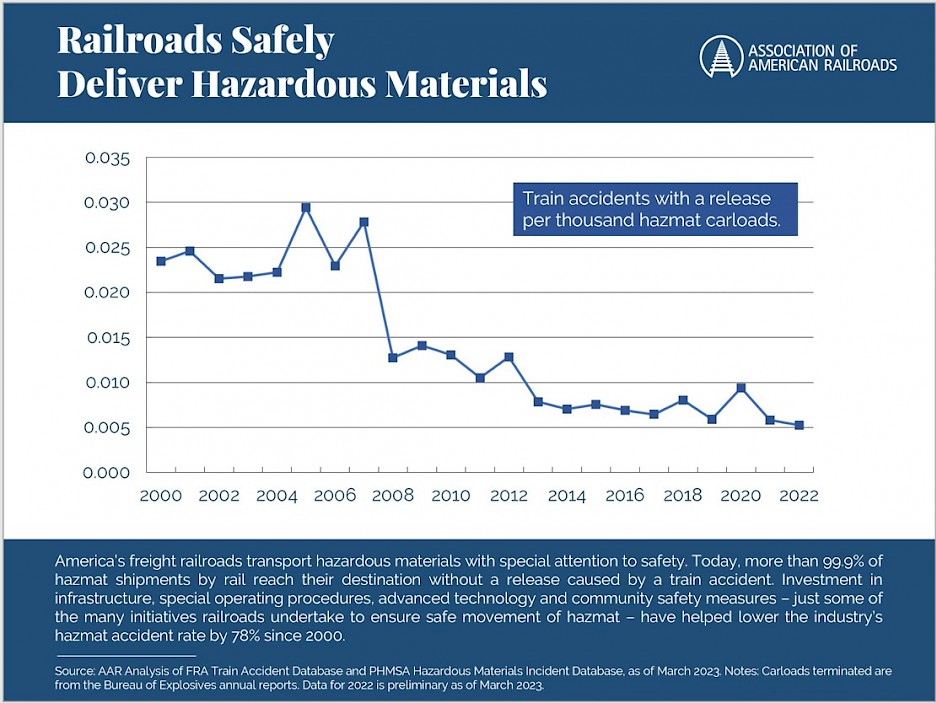- Agriculture & Food Defense, Articles, Fire, Hazmat, Public Health, Transportation
- Glen Rudner
Since February 3, 2023, following the train derailment in East Palestine, Ohio, the public has closely followed reports and commentary by media outlets and elected officials. This incident has become more controversial and publicized than others in recent years and has caused a public outcry for change. This article does not attempt to speculate on the details of an ongoing investigation, especially during a lengthy recovery phase. Instead, it serves as an important reminder to communities, responders, emergency management, local officials, and railroads to continue to work together to build knowledge and trust and provide training to mitigate future hazards.
Responding to hazardous materials (hazmat) incidents involves many considerations that are not always obvious from the public’s perspective. From an emergency preparedness perspective, it is critical to have a basic understanding of hazmat transports, the tools and resources for emergency responders, and the training available to prepare communities before an incident occurs.
Hazmat Rail Transports
Hazmat shipments by rail are common. Each year, the railroad industry ships approximately 3.1 billion tons of hazardous materials, including chlorine, anhydrous ammonia, ethylene oxide, sulfur dioxide (SO2), and others. While more than 99.9% of those shipments reach their destinations without issues, railroad incidents can and do occur. Rail incidents involving hazardous materials are low-frequency/high-consequence events.

Many hazmat shipments involve transporting raw materials to manufacture all kinds of consumer products and home-building materials. And when a high-profile incident like the one in East Palestine occurs, there is usually a public outcry for additional rules and restrictions on the railroad industry. In this age of around-the-clock news, social media, and a desire for immediate answers, it is more important than ever to have a strong and unified command supported by a strong crisis communications plan. Without timely and accurate information, people critique the response and add their own narratives.
Response Tools & Resources
When a hazmat incident occurs, responders need tools and resources to assist in identifying risks and threats and making critical decisions. RAILINC provides one of these mobile application tools called AskRail®. The AAR has made this app available to all authorized emergency responders. This tool is a collaborative effort between railroads and emergency responders and provides “immediate access to accurate, timely data about what type of hazardous materials a railcar is carrying so they can make an informed decision about how to respond to a rail emergency.” Authorized emergency responders can access the app by following the four-step process outlined at http://askrail.us.
The U.S. Department of Transportation’s Pipeline and Hazardous Materials Safety Administration also produces the highly respected Emergency Response Guidebook (ERG) as a reference for the initial response to a hazmat transportation incident. The ERG provides information for rail crew members, first responders, public safety officials, and other decision-makers regarding general safety precautions, notification procedures, rail car identification charts, protective clothing, decontamination, and more. After responders identify the hazardous material, they can refer to the ERG for initial emergency response instructions. Each material describes potential health and safety hazards, first aid instructions, protective clothing recommendations, evacuation procedures, and other immediate public safety information.
Hazmat incidents involve many considerations that are not always obvious. They require training and resources to make rapid life-saving decisions.
In addition to technological tools and published resources, certain key positions hold extensive knowledge and should be contacted immediately when an incident occurs. The railroad’s hazmat manager or dangerous goods officer can answer many of the initial questions. Once hazmat managers arrive on-site, they assess railcar conditions and damages. Railroad officials must become part of unified command so that local response and elected officials, state government representatives, and federal on-scene personnel all will be part of the decision-making process known as the unified command. Decisions should be made based on facts and science of the knowns present at the time. These knowns should consider the current environmental conditions, including but not limited to weather, topography, local population protection (evacuation or protection in place), and downwind/downstream impacts.
Preparedness and Planning Are a Must
The response to a hazmat incident begins with preparation and planning. Local emergency management, response organizations, and railroads are all important stakeholders. Preparedness and planning should not be an afterthought but an integral building block to a successful response. Railroads are training thousands of responders each year as part of a tremendous outreach initiative to recognize, identify, and notify the railroad during an incident. Each railroad also operates a website that includes information on how emergency response professionals can obtain additional resources and training:
- BNSF Hazmat
- Canadian National First Responders Training and Resources
- Canadian Pacific Hazmat Training
- CSX Emergency Responder Training and Education
- Norfolk Southern Operations Awareness & Response
- Union Pacific Working With First Responders
Other essential planning partners are the Local Emergency Planning Committees (LEPCs) and State Emergency Response Commissions (SERCs). Railroads should be active members of LEPCs and can offer exercises, drills, and connections to their local communities. In addition, railroads can assist with preplanning for incidents by offering commodity flow studies at no cost to the community.
There are also resources and training outside the rail industry. The Federal Emergency Management Agency (FEMA) makes planning tools available through the National Domestic Preparedness Consortium (NDPC), the Rural Domestic Preparedness Consortium (RDPC, which offers training to locations with populations of less than 50,000), or their partners. Led by industry professionals, Transportation Community Awareness and Emergency Response (TRANSCAER®) provides an outreach program in North America to prepare communities and train emergency responders for hazardous material transportation incidents. The International Association of Fire Chiefs offers free training, tools, and resources to hazmat teams, first responders, federal, state, and local agencies, and the private sector through its Hazardous Materials Fusion Center project.
Although hazmat rail incidents are low-frequency, any community located near a railroad should prepare for the possibility that an incident could occur nearby. The more prepared the local responders are, the quicker they can respond and identify the specific threat and hazards. Comprehensive preparedness and planning will build relationships and instill trust before a potential emergency. The result will be well-thought-out decisions and timely and accurate information to the public regarding the public’s safety.

Glen Rudner
Glen Rudner retired in 2022 as a manager of environmental operations for the Norfolk Southern (NS) Railway with environmental compliance and operations responsibilities in Tennessee, Alabama, Mississippi, and Louisiana. Previously, he was the hazardous materials compliance officer for NS’s Alabama Division (covering Alabama, Mississippi, Louisiana, and southwestern Tennessee). Prior to NS, he served as one of the general managers at the Security and Emergency Response Training Center in Pueblo, Colorado. He worked as a private consultant and retired as a hazardous materials response officer for the Virginia Department of Emergency Management. He has nearly 42 years of experience in public safety. He spent 12 years as a career firefighter/hazardous materials specialist for the City of Alexandria Fire Department, as well as a former volunteer firefighter, emergency medical technician, and officer. As a subcontractor, he served as a consultant and assisted in developing training programs for local, state, and federal agencies. He serves as secretary for the National Fire Protection Association Technical Committee on Hazardous Materials Response. He is a member of the International Association of Fire Chiefs Hazardous Materials Committee, a member of the American Society of Testing and Materials, and a former co-chairman of the Ethanol Emergency Response Coalition. He served as a member of the FEMA NAC RESPONSE Subcommittee.
-
Glen Rudnerhttps://www.domesticpreparedness.com/author/glen-rudner
-
Glen Rudnerhttps://www.domesticpreparedness.com/author/glen-rudner
-
Glen Rudnerhttps://www.domesticpreparedness.com/author/glen-rudner
-
Glen Rudnerhttps://www.domesticpreparedness.com/author/glen-rudner






